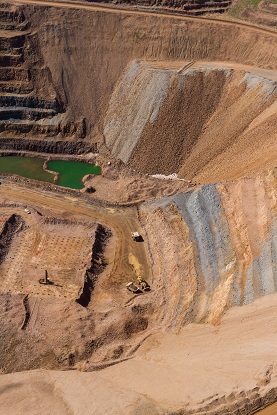New tools to manage mining’s impact

Related topics
Environment & climate action Innovation Belgium Croatia Germany Hungary Netherlands Romania Sweden United Kingdom Environment Russian Federation Bosnia And Herzegovina Ukrainedate: 11/08/2014
Project: Impact Monitoring of Mineral Resources E...
acronym: IMPACTMIN
See also: CORDIS
Contact: Contact
In 2011, Europe produced 1.6 billion metric tonnes of minerals, making it the world’s 3rd largest producer, behind Asia and North America. Mining has been practiced in Europe since the Romans in the 1st century AD and it is still an integral part of the European economy in employment and resource exports. While the volume of production has been declining since the 1990s, the industry still employs around 350,000 people.
Mining has often been associated with a range of potential negative environmental effects such as chemical exposure, soil erosion and post-mine clean-up. In response to this, the European Union (EU)-funded project ImpactMin developed state-of-the-art tools and practices for monitoring and managing mining activities throughout Europe, based on four case-study sites in Russia, Sweden, Bosnia and Herzegovina, and Romania. With an emphasis on innovation and efficiency, ImpactMin team focused on the use of remote sensing technologies, which uses sensors, on-board satellites, small aircrafts or even Unmanned Aerial Vehicles (UAVs) to gather information about the Earth’s surface or atmosphere.
The environmental impact of mining, which the ImpactMin researchers demonstrated in four sites across the EU, varies and depends upon the type of mining that is taking place. Results from the Mostar Valley demonstration site in Bosnia and Herzegovina indicated that there were increased concentrations of sulphate and hydroxide minerals in the vicinity of the mine, which were damaging the surrounding vegetation by contaminating the water. Remote sensing also helped locate expanding clays such as montmorillonite which can swell by up to 200% when wet and can then cause landslides.
At the Karabash test site in the Chelyabinsk region of Russia, where mining has been practiced for over 3,000 years, the ImpactMin team was able to identify substantial changes in soil conditions and vegetation stress levels in relation to the distance to the mine. The main impact-zone was up to 15km away from the mine, with evidence of acid precipitation and particles of toxic lead, zinc and arsenic. Such discoveries can be made with conventional field measurements, but the use of remote sensing technologies makes the process quicker and less expensive.
Unlike previous forms of mine monitoring, such as in-situ field measurements of chemical analysis and vegetation sampling, the ImpactMin researchers’ new methods could enable entire areas to be examined at once and at a relatively low price. “The scale of the impact can be very high which means that we cannot go to every single point to take field measurements. That is where satellite imagery is handy,” says ImpactMin project coordinator Peter Gyuris, from Geonardo Environmental Technologies Ltd. in Hungary.
The use of Unmanned Aerial Vehicles (UAVs) and small aircrafts was not entirely without difficulties, since safety and privacy concerns by local authorities occasionally meant that some methods could not be used in certain areas. “Over the course of the project, the research team was able to demonstrate the capability of these technologies to monitor the mining impact,” explains Gyuris. “The difficulties we encountered were more logistical rather than technological, so now that we are aware of them we can talk to legislators to ensure that such issues are resolved in the future,” he adds.
Another result of the project was the development of an online e-training platform. “The idea behind that was to disseminate the information about what we were doing. We targeted professionals in the mining industry, specialists in the remote sensing domain and, increasingly, university students,” says Gyuris.
ImpactMin could become an important base for future European mining projects. There are at least three upcoming projects funded by the European Commission that are targeting how to better use unexploited mining resources in Europe: EURARE, Minerals4EU and I2MINE.
